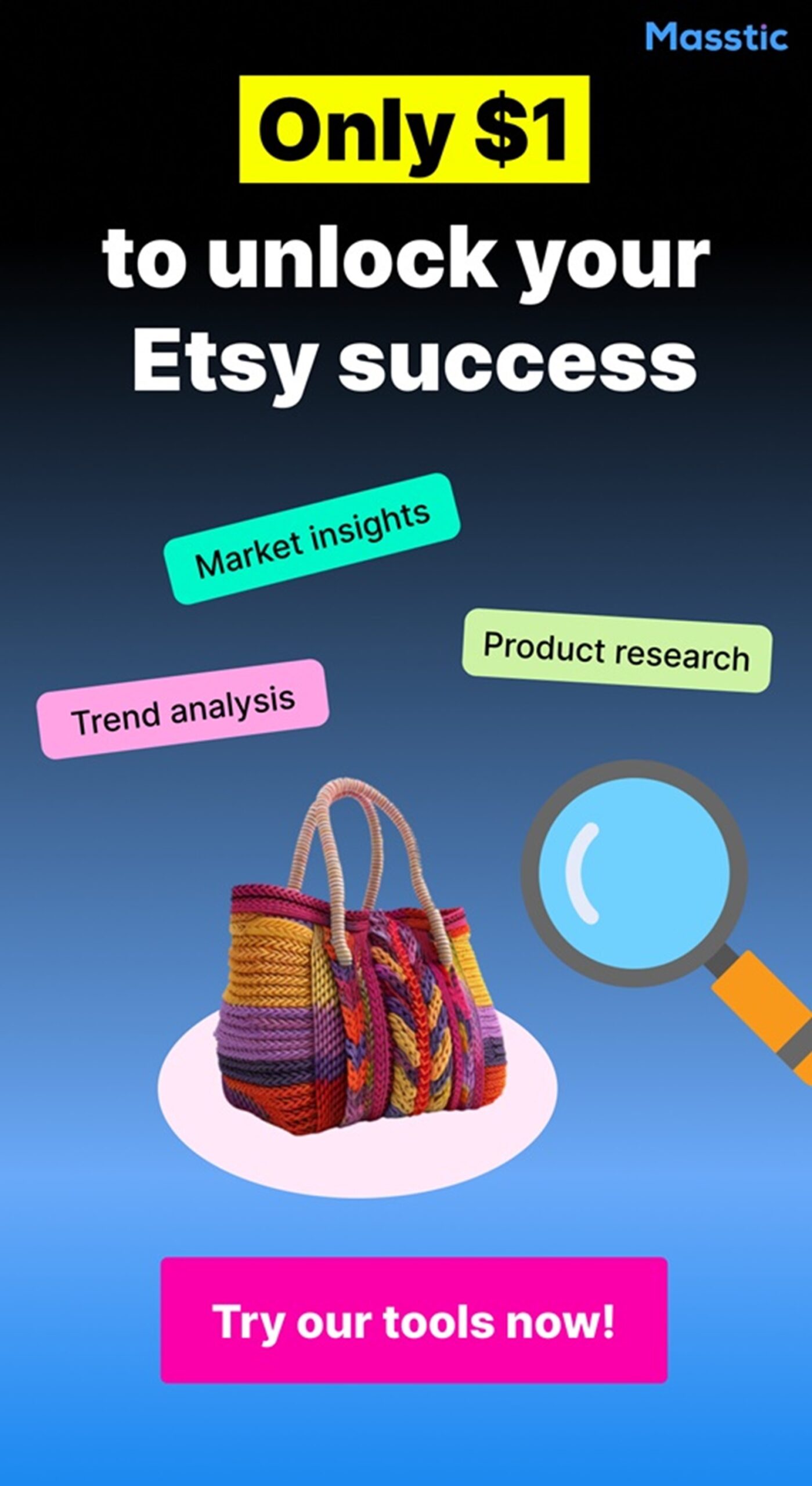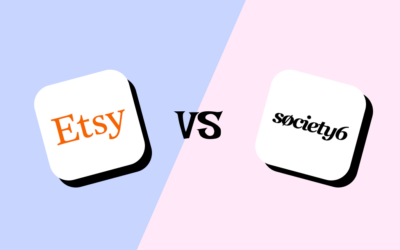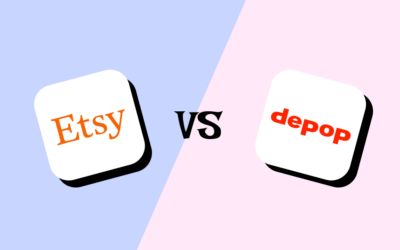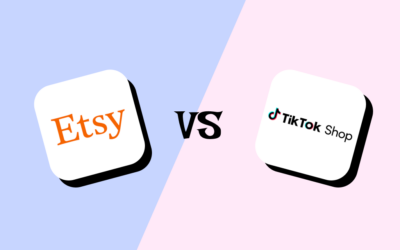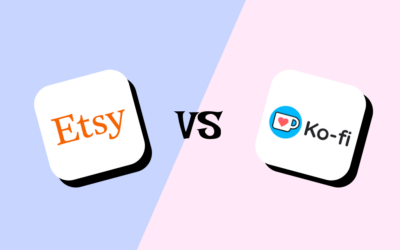Etsy vs Shopify: Which Is Better To Embark On Your Selling Journey?
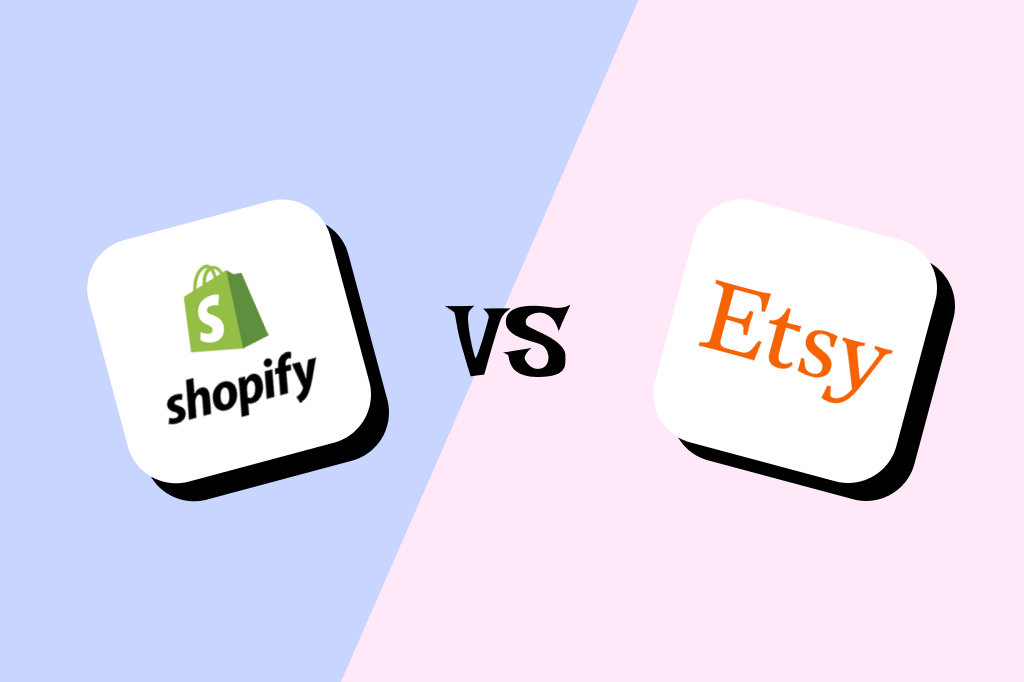
Whether you want to sell online for the first time or expand your existing store to the online channel, choosing the right platform can lay the groundwork for your success. And usually, most people don’t know which to pick between two popular options– Etsy vs Shopify.
The hesitation is real and reasonable, though. This is because selling on Etsy vs Shopify both come with their strengths and potential setbacks.
But don’t worry! In this article, we will compare them under seven crucial aspects to give you a visualize which one works better for your business.
Pros and cons of Etsy vs Shopify
Etsy’s overview
Etsy is a famous online marketplace that connects buyers and sellers of custom, handmade products worldwide. Thanks to its vast global audience of 93 million active buyers, Etsy has been a go-to choice of many artists, retailers, and even dropshippers.
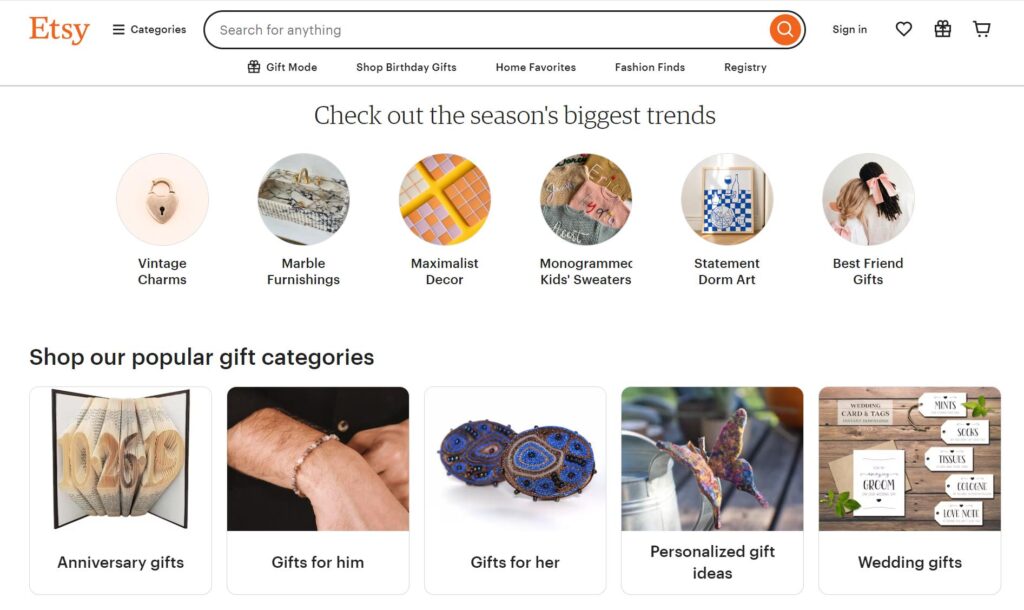
| Pros | Cons |
| + Setting up a store with Etsy is very fast and easy + Etsy has over 90 million active buyers for you to tap into + It’s faster to experiment and validate your product ideas | – It’s more suitable for handmade and custom product categories – The platform’s listing fees can be high if you process large sales volumes |
Shopify’s overview
Unlike Etsy, Shopify is not a marketplace. Instead, you pay Shopify a monthly licensing fee to host your own eCommerce web store with Shopify. This means you have a custom domain and a whole website which you can freely customize as you see fit.
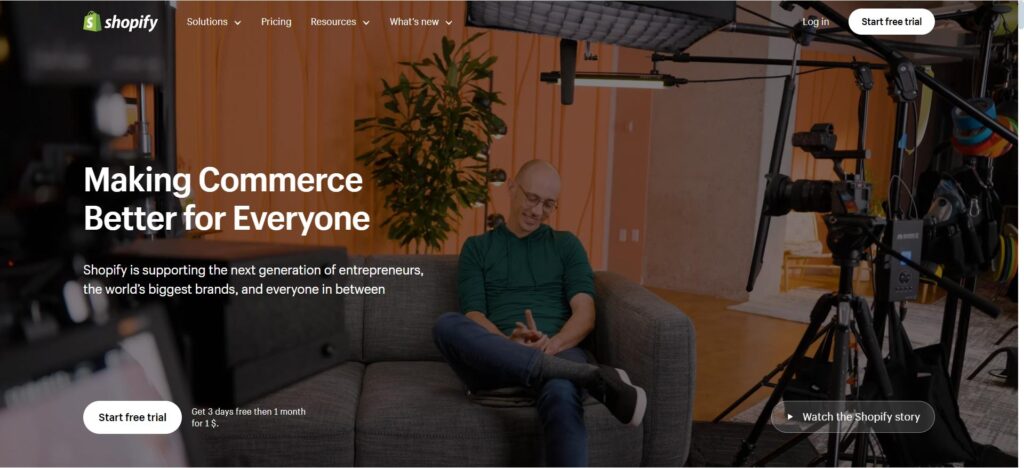
| Pros | Cons |
| + You have a customizable website with a custom domain for your own + You have many built-in sales and marketing tools to sell online + The Shopify App Store has over 8,000 robust apps | – You have to drive your own traffic and convert them into leads and sales – It takes more time to validate which product/niche works and which doesn’t – Shopify charges extra transaction fees for stores that do not use its own payment gateway |
>> Check our list of the best Etsy alternatives to see how Etsy stacks up against 13+ popular eCommerce solutions.
Etsy vs Shopify: A head-to-head comparison
1. Target audience
| 🔎 Key takeaways: Etsy vs Shopify cater to different business models. By product: Etsy provides a niche marketplace for creators of handmade, vintage, and custom items. Meanwhile, Shopify gives users a full suite of sales tools so they can list and sell any type of products on their own website. By purpose: Etsy is for sellers who want to take advantage of the marketplace’s audience. Shopify is for those who needs more control over their website’s branding and marketing activities. |
Etsy’s target audience
At its core, Etsy is an online marketplace that acts as a bridge between sellers and buyers. It’s similar to marketplaces like Amazon or Alibaba on this note. However, unlike other marketplaces, Etsy is well-known for its focus on custom, handmade, and vintage items.
Because Etsy is a marketplace designed for millions of stores and shoppers, the platform will give you very little control over your store layout. However, with a massive number of buyers from every corner of the world, your product listings on the platform will likely have better visibility than a new website.
This also means you can test your products faster. Particularly, Etsy’s large audience allows you to quickly gauge interest in new products without the lengthy process of building traffic to a new website.
Shopify’s target audience
Shopify is very different from Etsy by nature, and, of course, its target audience as well. Think of Shopify as an eCommerce website builder that lets sellers build an online store easily.
We think the biggest difference between Etsy vs Shopify is that people can sell all kinds of products with Shopify instead of just handmade items like on Etsy.
Though the platform doesn’t bring your products in front of millions of buyers worldwide as Etsy does, Shopify allows you to fully customize your store and drive sales with great built-in sales tools.
2. Cost and fees
| 🔎 Key takeaways: Etsy vs Shopify fees have different structures. If you’re just starting out, Etsy is more affordable with its per-listing and transaction fees because the listing fee is only $0.2/listing, and you only have to pay Etsy for successful sales. For growing businesses with higher sales volumes, Shopify’s flat monthly rate could prove more cost-effective in the long run. |
Disclaimer: Please note that the information about Etsy fees vs Shopify fees is subject to change by the platforms.
Etsy’s cost and fees
If you plan to list and sell your products on Etsy, then there are three main fees you need to account for:
| Fee type | Definition | How much is it? |
| Listing fees | These are the fees Etsy charges you for listing products on their marketplace | + Base: $0.20 per listing + Auto-renewal: $0.20 per listing + Multi-variant: $0.20 per listing + Private listing: $0.20 per private listing |
| Transaction fees | These are the fees Etsy charges when a shopper makes a purchase on your store | 6.5% of the total amount in your listing currency |
| Payment processing fees | These fees are charged on each transaction that is processed with Etsy Payments. | It varies by country. For instance, the fee is 3% + $0.25 in the US. |
The good thing about Etsy’s selling fees is that you can start a shop with a very small budget (ony $0.20 per listing) and you only have to pay Etsy when you successfully make a sales.
Shopify’s cost and fees
Shopify’s cost structure is a bit different than Etsy’s. The platform doesn’t charge listing or transaction fees; however, there are other costs to concern:
| Fee type | Definition | How much is it? |
| Custom domain name | Unless you buy your own custom domain, your shop’s URL will end with the default .myshopify.com | $10 – $30 per year |
| Licensing fee | This is the fee Shopify charges you for hosting your store on the Shopify server | + Basic Shopify: $39/month + Shopify: $105/month + Advanced Shopify: $399/month + Shopify Plus: from $2,300/month |
| Payment processing fees | These are the fees that credit card firms or payment processors charge you for each successful transaction. | + Basic Shopify: 2.9% + $0.30 + Shopify: 2.7% + $0.30 + Advanced Shopify: 2.5% + $0.30 + Shopify Plus: 2.15% + $0.30 |
| Extra transaction fees | If you do not use Shopify Payments, you’ll be charged this additional fee on each transaction. | + Basic Shopify: 2% + Shopify: 1% + Advanced Shopify: 0.6% + Shopify Plus: 0.2% |
Unlike Etsy, Shopify’s subscription pricing model means you have to pay Shopify a recurring licensing fee (monthly or annually) whether you make a sale or not. Therefore, if you just get started with a low budget, launching a Shopify store might leave you with a very thin profit margin.
3. Ease of setup
| 🔎 Key takeaways: Etsy is generally easier to set up than Shopify. While Etsy allows you to quickly start selling on an established marketplace, Shopify might require more time and effort to build a standalone online store from scratch. |
Etsy’s ease of setup
Setting up an Etsy shop is as easy as 1,2,3. All you have to do is create a seller account and begin listing products on the marketplace quickly. As you proceed, Etsy will guide you through each step, requesting essential information such as your shop name and payment details.
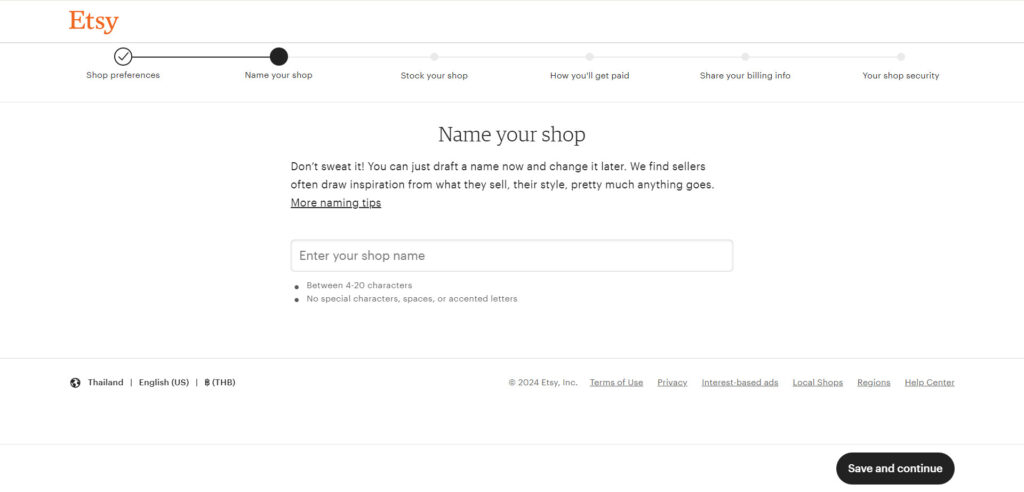
And since Etsy already provides you with a ready-made store layout, you won’t need to worry about web design, hosting, or buying a custom domain. All you have to do is list your products and start selling.
>> Explore our 101 guide on how to sell on Etsy for beginners.
Shopify’s ease of setup
Among hosted eCommerce platforms, Shopify is famous for its ease of use and intuitive dashboard. However, comparing Etsy vs Shopify in terms of ease of setup, Shopify is still far behind its counterpart.
With Shopify, it’s also as quick as Etsy to list your products. However, you will have to set up many other things as well. To name a few, you have to customize your website’s looks and feels, buy and connect your custom domain, etc.
4. Storefront design
| 🔎 Key takeaways: Shopify offers more customizations for storefront design. While Etsy provides a standard layout for all shops, Shopify allows you to create a unique, branded store that can be fully customized to your needs. |
Etsy’s storefront design
When it comes to storefront design, Etsy offers a relatively standardized approach. All Etsy shops share a similar layout, which we believe to be both a blessing and a limitation.
On one hand, this uniformity ensures that your store will have a clean, professional look without much effort on your part. For example, Etsy does allow you to customize certain elements, such as your shop banner, logo, product photos, etc.
Take a look at the layout of SurfingSloth– a popular Etsy shop selling greeting cards.
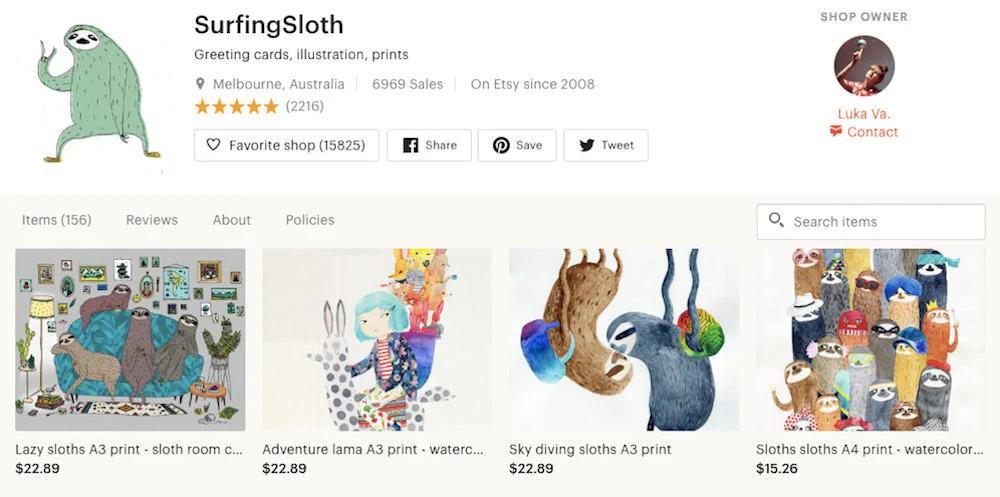
Though you may find that your ability to customize your store layout on Etsy is limited, we believe its standardized layout isn’t that bad. Personally, what we like about the Etsy layout is that it’s already optimized with user experience and conversion best practices in mind.
Shopify’s storefront design
By contrast, Shopify provides a much more flexible approach to storefront design. To be more particular, you can choose from various themes on the Shopify Theme Store and customize them with Shopify’s built-in drag-and-drop editor.
And if you’re comfortable with coding, you can even tweak Shopify’s Liquid code for more advanced modifications to your store’s looks and feels.
5. Sales features
| 🔎 Key takeaways: It’s a tie. Shopify offers you many advanced, out-of-the-box sales features. Etsy, while gives you some basic sales features to sell and manage your store’s operations, comes with a free built-in review rating system. |
Etsy’s sales features
Etsy gives you several sales features to sell your products and manage your order, and inventory effectively. Specifically, here are the notable sales features Etsy offers:
- Order management: Etsy allows you to easily track and fulfill orders
- Built-in review management: When your customers buy your products, they can leave a detailed review with images on your listing.
- Payment processing: You can accept your customers’ payments with Etsy Payments
- Analytics and reporting: You can track and monitor your store’s important metrics like traffic sources, visits, conversion rate, etc.
- Coupons: You can create coupons and offer them to your customers easily.
Shopify’s sales features
Unlike Etsy, Shopify doesn’t offer native review features– a very important functionality to build trust among shoppers. To collect and display customer reviews on your Shopify store, you’d have to use a review app.
With that being said, Shopify generally gives you more sales features. For instance, here are some Shopify sales tools that you might find handy:
- Localization: With Shopify Markets, you can set different pricing offerings for different markets and accept payments in local currencies, providing a tailored experience for international customers.
- Advanced abandoned cart recovery: Shopify offers automated email campaigns to remind customers about items left in their carts.
- B2B and wholesale capabilities: Shopify Plus offers features for B2B selling, including custom pricing, minimum order quantities, and customer-specific catalogs.
- Subscription sales: Though it requires a Shopify app, Shopify allows you to sell your products under subscription
- POS system: You can sync your online and offline store’s stocks, customers, etc and allow your customers to buy online, pick up in store (BOPIS) if needed. This flexibility makes it easy to manage inventory and enhance customer convenience, making it one of the best POS systems for small business setups.
6. Print-on-demand capabilities
| 🔎 Key takeaways: Comparing print-on-demand Etsy vs Shopify, both let you sell print-on-demand. However, Shopify supports this business model better than Etsy, thanks to its extensive app integration. |
Etsy’s print-on-demand capabilities
Thanks to Etsy’s integration with popular print-on-demand services like Printify or Printful, sellers can create listings for customizable items like t-shirts, mugs, or posters, which are then produced and shipped by a third-party print-on-demand service when an order is placed.
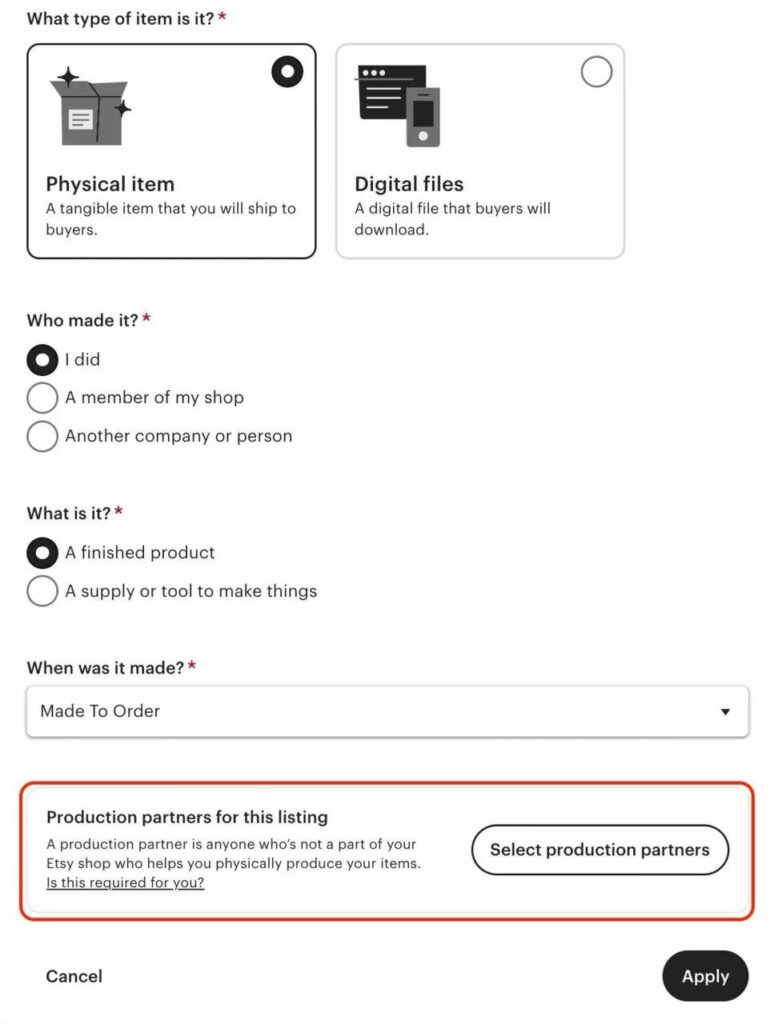
However, Etsy’s customization options are limited compared to Shopify. Customers cannot customize products directly on the Etsy platform, which means sellers may need to manually collect customization details and create print files for each order.
Shopify’s print-on-demand capabilities
When putting Shopify vs Etsy for print on demand into comparison, it’s obvious that Shopify has more to offer. With Shopify, merchants can create fully customized online stores and integrate with a wide range of print-on-demand suppliers through Shopify’s extensive app ecosystem.
For example, your customers to personalize the print-on-demand products they want to buy with text, images, and designs directly on your product pages.
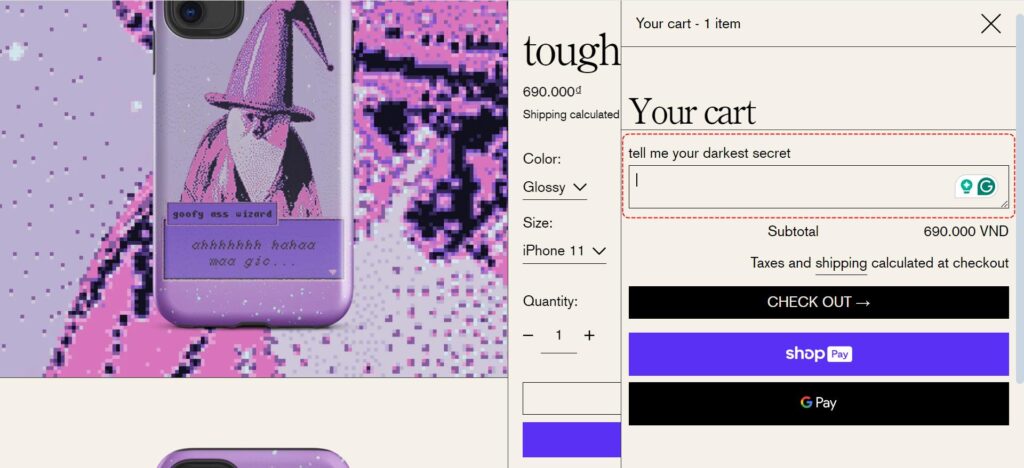
7. SEO and marketing features
| 🔎 Key takeaways: Promoting your products is more efficient on Etsy than Shopify. Apparently, Shopify gives you more marketing tools in general. However, launching a new Shopify website means you must put in tremendous effort to drive your first traffic. While Etsy seemingly has fewer tools to offer, as long as you properly optimize your listings on the marketplace, you can easily drive traffic to your product listings. And if you have a budget, you can run Etsy ads to target high-intensity buyers who are actively searching for your products. |
Etsy’s SEO and marketing features
As a typical marketplace with an extensive customer base, Etsy offers sellers three main marketing and promotion functionalities:
- SEO tools: You can optimize your listings with relevant keywords in titles, tags, and descriptions to improve visibility within Etsy’s search results.
- Etsy Ads: Promote listings within the Etsy marketplace through a pay-per-click advertising system with customizable budgets.
- Social media sharing: Easily share product listings on popular social media platforms to increase visibility and drive traffic
Shopify’s SEO and marketing features
Unlike Etsy, Shopify doesn’t come with a super large user base. Hence, it makes sense that the platform gives you more marketing features to promote your brand-new website such as:
- Blog integration: You can create a blog page with Shopify and create insightful blog posts to boost your rankings, topical authority, etc. on Google
- Email marketing: Etsy doesn’t let you collect your customers’ email, let alone running various email campaigns like you can do with Shopify Email.
- Customer segmentation: With Shopify, you can create targeted marketing campaigns based on customer behavior, purchase history, and demographics.
- Loyalty program: With loyalty apps, you can run loyalty programs to retain your shoppers and drive repeat purchases.
Although Shopify offers numerous marketing tools, you should be noted that running and testing your campaigns, product ideas, etc. can drain your time and budget.
Which one is better, Shopify or Etsy: Final thoughts!
Now that you have made it this far, it’s now much easier to choose between Etsy vs Shopify, isn’t it?
Let’s pick a platform where you can embark on your selling journey:
| Choose Etsy when | Choose Shopify when |
| + You’re selling handmade, vintage, or unique craft supplies + You’re just starting out and prefer a simpler platform with lower upfront costs and no monthly fees + You want to take advantage of the marketplace’s active buyers instead of doing all the hard work on your own | + You have a diverse product range beyond handmade items + You want to build a branded, customizable online store + You’re planning to scale your business and need advanced features like multi-channel selling, detailed analytics, etc. |
Final thoughts
Etsy vs Shopify are both powerful platforms to list and sell your products online. At the end of the day, there’s no such thing as a better platform, only a platform that suits you better.
Therefore, Masstic hopes ater reading this comparison article, you can choose a platform that better aligns with your product, business and goals.
If you are a newbie who wants to quickly list your crafts on a popular marketplace and focus on selling, Etsy would be a more suitable choice. And if you are an established business with a strong branding and an existing customer base already, creating a Shopify store would make sense as well.
Shopify vs Etsy for artists: FAQs
Is Etsy better or Shopify?
It depends. If you are a complete newbie with no branding yet and you want to sell handmade, custom products online, we believe Etsy is the best choice.
However, if you are an established store with adequate brand recognition and an existing customer base, we think launching a Shopify store would make more sense.
What is the downside of Etsy?
The biggest downside of Etsy is probably its limited storefront design customization. Unlike Shopify, Etsy doesn’t leave you much to do with how your store looks and works.
When should I move from Etsy to Shopify?
You can consider moving from Etsy to Shopify if you are in the phase when branding is the bloodline of your business.
Does Shopify have fees like Etsy?
Yes, besides the monthly subscription fee from $25 to $399/month, Shopify charges you an extra transaction fees from 0.6% to 2% unless you use Shopify Payments.

